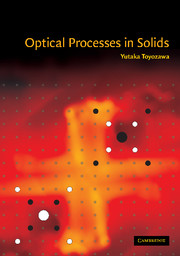Book contents
- Frontmatter
- Contents
- Preface
- Acknowledgments
- List of principal symbols
- 1 Radiation field
- 2 Quantum mechanics
- 3 Interaction of radiation with matter
- 4 Electronic vs. nuclear motions and the optical spectra of localized electrons in solids
- 5 Lattice vibrations
- 6 Electric susceptibility and dielectric constant
- 7 One-electron states in solids
- 8 Excitons
- 9 Polaron and the self-trapped state
- 10 Optical spectra of exciton in the phonon field Overview
- 11 Higher-order optical processes
- 12 Inner-shell excitation
- 13 Photo-induced structural changes
- 14 Light, matter and life (A scenario for the origin of life and its evolution)
- Appendix 1 Derivation of exciton Hamiltonian from many-body Hamiltonian
- Appendix 2 Transient spectra for second-order optical processes
- References (by chapter)
- Subject index
8 - Excitons
Published online by Cambridge University Press: 10 December 2009
- Frontmatter
- Contents
- Preface
- Acknowledgments
- List of principal symbols
- 1 Radiation field
- 2 Quantum mechanics
- 3 Interaction of radiation with matter
- 4 Electronic vs. nuclear motions and the optical spectra of localized electrons in solids
- 5 Lattice vibrations
- 6 Electric susceptibility and dielectric constant
- 7 One-electron states in solids
- 8 Excitons
- 9 Polaron and the self-trapped state
- 10 Optical spectra of exciton in the phonon field Overview
- 11 Higher-order optical processes
- 12 Inner-shell excitation
- 13 Photo-induced structural changes
- 14 Light, matter and life (A scenario for the origin of life and its evolution)
- Appendix 1 Derivation of exciton Hamiltonian from many-body Hamiltonian
- Appendix 2 Transient spectra for second-order optical processes
- References (by chapter)
- Subject index
Summary
Frenkel excitons
When we considered low-energy elementary excitations such as optical phonons (Section 5.3) and the low-energy binding of donor electrons (Section 7.4), we described the background polarization effect of the electrons tightly bound to host atoms phenomenologically in terms of a constant susceptibility ∈e – ∈0 assuming that the polarizations have characteristic frequencies high enough to follow instantaneously the aforementioned low-frequency motions. In this chapter we will be concerned with the high-energy elementary excitations of tightly bound electrons contributing to susceptibility ∈e – ∈0 of the background polarization, in particular with excitons, which is a first step to incorporating configuration interactions among one-electron excitations.
As the simplest model, consider an isolated atom (or ion) with one electron in the 1s state with energy ε1s. An applied electric field gives rise to electronic polarization of the atom which quantum mechanically is due to the mixing of wave functions of odd parity np(n = 2, 3, …) states with energies εnp to that of the even-parity 1s state. After the field is removed, the mixing coefficients contributing to the polarization oscillate with angular frequencies ωn = (εnp – ε1s)/ħ. Namely, the elementary excitations responsible for the polarization of an atom are excitations of its electron to higher states with different parity.
If identical atoms (or molecules) form an assemblage, the excitation of an atom resonates with those of neighboring atoms and, via the interatomic interactions, the excitation energy will propagate from atom to atom like a wave if the atoms are arrayed on a crystal lattice.
- Type
- Chapter
- Information
- Optical Processes in Solids , pp. 113 - 148Publisher: Cambridge University PressPrint publication year: 2003
- 1
- Cited by

